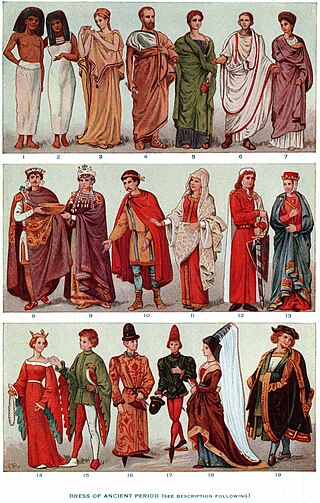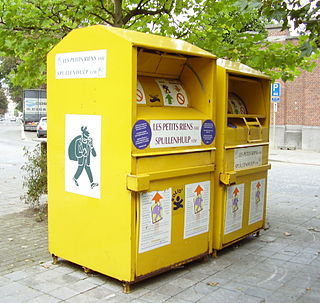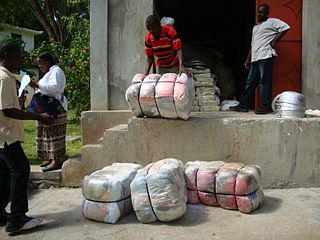Related Research Articles

Fashion is a term used interchangeably to describe the creation of clothing, footwear, accessories, cosmetics, and jewellery of different cultural aesthetics and their mix and match into outfits that depict distinctive ways of dressing as signifiers of social status, self-expression, and group belonging. As a multifaceted term, fashion describes an industry, styles, aesthetics, and trends.

Clothing is any item worn on the body. Typically, clothing is made of fabrics or textiles, but over time it has included garments made from animal skin and other thin sheets of materials and natural products found in the environment, put together. The wearing of clothing is mostly restricted to human beings and is a feature of all human societies. The amount and type of clothing worn depends on gender, body type, social factors, and geographic considerations. Garments cover the body, footwear covers the feet, gloves cover the hands, while hats and headgear cover the head, and underwear covers the private parts.

A sweatshop or sweat factory is a crowded workplace with very poor or illegal working conditions. The manual workers are poorly paid, work long hours, and experience poor working conditions. Some illegal working conditions include poor ventilation, little to no breaks, inadequate work space, insufficient lighting, or uncomfortably or dangerously high or low temperatures. The work may be difficult, tiresome, dangerous, climatically challenging, or underpaid. Workers in sweatshops may work long hours with unfair wages, regardless of laws mandating overtime pay or a minimum wage; child labor laws may also be violated. Women make up 85 to 90% of sweatshop workers and may be forced by employers to take birth control and routine pregnancy tests to avoid supporting maternity leave or providing health benefits.

Used goods, also known as secondhand goods, are any item of personal property offered for sale not as new, including metals in any form except coins that are legal tender, but excluding books, magazines, and postage stamps. Used goods may also be handed down, especially among family or close friends, as a hand-me-down.

Zara is a Spanish multinational fast-fashion company. It sells clothing, accessories, beauty products and perfumes. The head office is located at Arteixo in the province of A Coruña, Galicia. It is the largest constituent company of the Inditex group. In 2020, it was launching over twenty new product lines per year.

African clothing is the traditional clothing worn by the people of Africa.

Fashion in the 1990s was defined by a return to minimalist fashion, in contrast to the more elaborate and flashy trends of the 1980s. One notable shift was the mainstream adoption of tattoos, body piercings aside from ear piercing and, to a much lesser extent, other forms of body modification such as branding.

Fast fashion is the business model of replicating recent catwalk trends and high-fashion designs, mass-producing them at a low cost, and bringing them to retail quickly while demand is at its highest. The term fast fashion is also used generically to describe the products of this business model, particularly clothing and footwear. Retailers who employ the fast fashion strategy include Primark, H&M, Shein, and Zara, all of which have become large multinationals by driving high turnover of inexpensive seasonal and trendy clothing that appeals to fashion-conscious consumers.
The study of the history of clothing and textiles traces the development, use, and availability of clothing and textiles over human history. Clothing and textiles reflect the materials and technologies available in different civilizations at different times. The variety and distribution of clothing and textiles within a society reveal social customs and culture.

Textile recycling is the process of recovering fiber, yarn, or fabric and reprocessing the material into new, useful products. Textile waste is split into pre-consumer and post-consumer waste and is sorted into five different categories derived from a pyramid model. Textiles can be either reused or mechanically/chemically recycled.

Sustainable fashion is a term describing efforts within the fashion industry to reduce its environmental impacts, protect workers producing garments, and uphold animal welfare. Sustainability in fashion encompasses a wide range of factors, including cutting CO2 emissions, addressing overproduction, reducing pollution and waste, supporting biodiversity, and ensuring that garment workers are paid a fair wage and have safe working conditions.
Anti-sweatshop movement refers to campaigns to improve the conditions of workers in sweatshops, i.e. manufacturing places characterized by low wages, poor working conditions and often child labor. It started in the 19th century in industrialized countries such as the United States, Australia, New Zealand and the United Kingdom to improve the conditions of workers in those countries. These campaigns are meant to improve the working conditions through advocacy for higher wages, safer conditions, unionization and other protections. These campaigns are meant to improve the working conditions through advocacy for higher wages, safer conditions, unionization and other protections. While they are meant to undermine the reputation of companies using sweatshop labor, they are not statistically significant as intended.
The Zambian term salaula means "to select from a pile in the manner of rummaging" or for short, "to pick". Some African nations such as Zambia have a vast internal consumer demand for second-hand clothes or hand-me-downs from rich nations in North America and Europe. The clothes arrive in these local markets in large bales or packages and are then cut open so buyers can sort through them and pick what article they like the most.

The global trade of secondhand clothing is a long-standing industry, which has been facilitated by the abundance of donated clothing in wealthy countries. This trade accounts for approximately 0.5% of the total value of clothing traded worldwide, while by weight it accounts for 10%. However, in some countries, imported used clothing constitutes the majority of clothing purchased and used.

Clothing industry or garment industry summarizes the types of trade and industry along the production and value chain of clothing and garments, starting with the textile industry, embellishment using embroidery, via the fashion industry to apparel retailers up to trade with second-hand clothes and textile recycling. The producing sectors build upon a wealth of clothing technology some of which, like the loom, the cotton gin, and the sewing machine heralded industrialization not only of the previous textile manufacturing practices. Clothing industries are also known as allied industries, fashion industries, garment industries, or soft goods industries.

BeGood Clothing is a retailer of clothing and accessories, selling its products online and focused on socially responsible clothing. The company is based in San Francisco, California. BeGood Clothing advances its mission as a socially responsible brand mainly through two initiatives: (i) the company features sustainable fashion and gifts that are eco-friendly, and (ii) the company gives back to an environmental or humanitarian cause for each item purchased. The company supports local San Francisco nonprofits, participates in charitable events, and donates customers’ gently used clothing to Goodwill Industries monthly.

Fashion Revolution is a not-for-profit global movement represented by Fashion Revolution CIC with teams in over 75 countries around the world. Fashion Revolution campaigns for reform of the fashion industry with a focus on the need for greater transparency in the fashion supply chain. Starting in 2014, Fashion Revolution marks the anniversary of the Rana Plaza disaster in Bangladesh with Fashion Revolution Week and holds events each year. Between 2014 and 2020, millions of people around the world called on brands to answer the question Who Made My Clothes? The hashtag #WhoMadeMyClothes became the no.1 global trend on Twitter. They have faced criticisms specifically about the Global Fashion Transparency Index.

Slow fashion is an aspect of sustainable fashion and a concept describing the opposite to fast fashion, part of the "slow movement" advocating for clothing and apparel manufacturing in respect to people, environment and animals. As such, contrary to the industrial practices of fast fashion conglomerates, slow fashion involves local artisans and the use of eco-friendly materials, with the goal of preserving crafts and the environment which, ultimately, provides value to all, slow fashion brands, consumers and retailers.

The fashion industry, particularly manufacture and use of apparel and footwear, is a significant driver of greenhouse gas emissions and plastic pollution. The rapid growth of fast fashion has led to around 80 billion items of clothing being consumed annually, with about 85% of clothes consumed in United States being sent to landfill.

The fashion industry in Nigeria plays an important cultural role and contributes significantly to the country's economy. Clothing incorporates a variety of colours, fabrics, and embellishments. Many of the component cultures of Nigeria wear styles that are characteristic of their tribal society and customs. Nigeria produces fashionable textiles and finished garments and has designers who have achieved international recognition.
References
- ↑ "East Africa's used-clothes trade comes under fire". The Economist. Retrieved 2017-07-06.
- ↑ Germany, SPIEGEL ONLINE, Hamburg (8 January 2006). "GLOBALISIERUNG: Das Hemd des toten Weißen - DER SPIEGEL 2/2006". Der Spiegel (in German). Retrieved 2017-07-30.
{{cite news}}: CS1 maint: multiple names: authors list (link) - ↑ gloriasb (2017-07-05). "Do African Nations Want Your Second-Hand Clothes? Yes and No". AlterNet. Retrieved 2017-07-06.
- ↑ Rivoli, Pietra (2009-04-01). The Travels of a T-Shirt in the Global Economy: An Economist Examines the Markets, Power, and Politics of World Trade. John Wiley & Sons. ISBN 9780470456422.